Part one of this article discusses the ways in which storyboarding relates to comics as a visual, storytelling medium. Check it out for an explanation of storyboard frame dimensions, shot terminology, and camera movement.
Not everything about storyboarding translates perfectly to making comics. All movement is implied in comics. Although storyboards are technically just as static, film literally captures movement.
Actually, scratch that. Comic panels may not observably move, but in the mind’s eye, they do.
Think about it. Through the composition of the panel, the viewer is forced to move their eye in the direction the artist wants. This may or may not coincide with the implied path that the character will follow out of frame. The size, shape, and sequence of panels determines the pacing of the story for the reader. You can control movement, of a sort.
Since all of that movement only happens in the mind’s eye, it is critical that you avoid doing anything to confuse the reader. There are ways to structure the elements of a panel, as with a sequence of shots in a film, so that the action remains clear and consistent.
Let me tell you about a little something called continuity.
Continuity
By maintaining a consistent direction of character movement and orientation within a scene, the director of a film helps the audience to follow the story without getting lost. This principle of maintaining consistency within shots is called continuity. Even in a small environment, it’s possible to put a camera in dozens of places. Assuming that you point it at the focal character, this still leaves a number of options. Do you film the subject from the front or the back? Is she to the left or right of frame? Which way is she moving? Choices abound.
A continuous scene is comprised of a variety of cuts and angles, so any inconsistency of movement or placement threatens to break the illusion within the mind of the viewer. For instance, the character may travel in the same direction across multiple shots, yet if the camera jumps back-and-forth across her path it will render the sequence visually disorienting.
Continuity of Movement
It’s very important that you remain aware of the direction of character movement when planning the sequence of shots that comprise a scene. Movement on screen comes down to a choice: left-to-right movement or right-to-left movement. Whichever direction the character appears to move at first, that is the direction he should continue throughout the sequence, provided that he does not turn around. The camera can be placed at a variety of distances and angles from the subject so long as the apparent direction of character movement is the same across all shots in that scene.
Lets examine the following sequence of a character exploring an abandoned house to see this concept demonstrated.
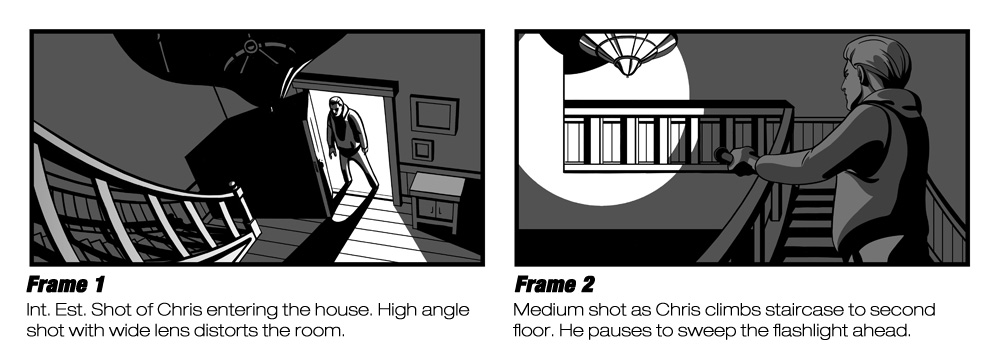
It begins with an interior establishing shot from a high vantage point. Chris, the character, swings open the front door and steps forward. His movement appears right-to-left which immediately establishes screen direction — how movement is oriented relative to the screen — for all successive shots in the scene. For the remainder of the sequence, forward progress equals right-to-left movement.
The second frame features a very different angle. Instead of being positioned in front/above, the camera is behind/below Chris. Fortunately, as he occupies the same area of the screen (i.e. to the right), the audience will already be looking at the correct location when the transition occurs. His movement remains right-to-left, although we may not see a significant change of position for the character. As Chris swings the flashlight to the left our eyes continue in that direction.
This seems like the perfect time to mention a related technique. Notice how Chris always has a buffer of space between himself and the frame border in the direction that he’s moving? That’s referred to as “lead room.” Make sure that you allow for lead room when composing a frame so that the audience can see where the character is going. If you don’t include that space before the character, it’s the equivalent of asking someone to walk through a room without looking in front of them. It’s disconcerting, and the audience will be uncomfortable.
Of course, that may be exactly the reaction you want. Frequently, horror and suspense films will eliminate lead room in their shots so that the audience nervously anticipates all of the things that can’t be seen.
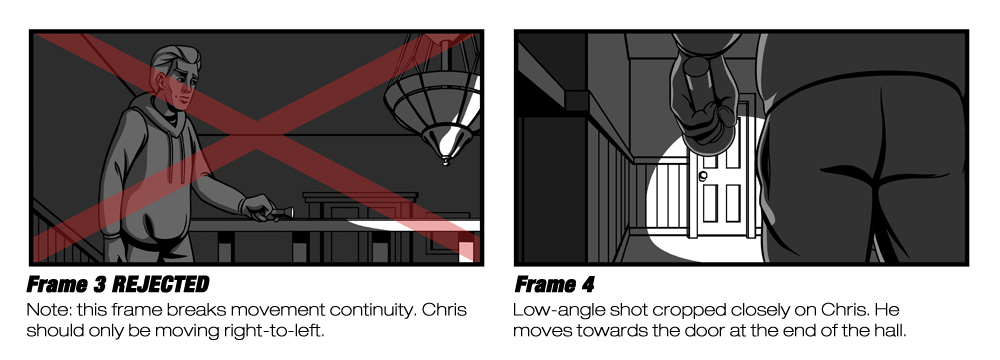
I included frame 3 as an example of “what not to do.” On it’s own, it’s a perfectly serviceable shot. In sequence with the rest of the scene however, it doesn’t work.
If the reason why isn’t apparent, consider frames 2, 3, and 4 in sequence. On the screen they will replace one another rather than be arranged like this. As the viewer, you would start by looking at Chris in frame-right moving left. Abruptly, in frame three he would jump to frame-left and be moving right. And finally, back to frame-right moving left with the fourth frame. Even though Chris is walking through the environment in the same way with every shot, this sequence is disruptive and confusing.
Which brings us to frame 4. In part one of this article, I mentioned that close-ups and extreme close-ups don’t always have to focus on the face. I composed the shot like this for the following reasons:
- I wanted to increase the sensation of claustrophobia and foreboding, so I framed Chris extremely close to the camera.
- To maintain continuity of movement, Chris is on screen-right moving left.
- This close-up focuses attention on the door at the end of the hallway. Because of the composition, Chris is literally pointing towards it with the flashlight.
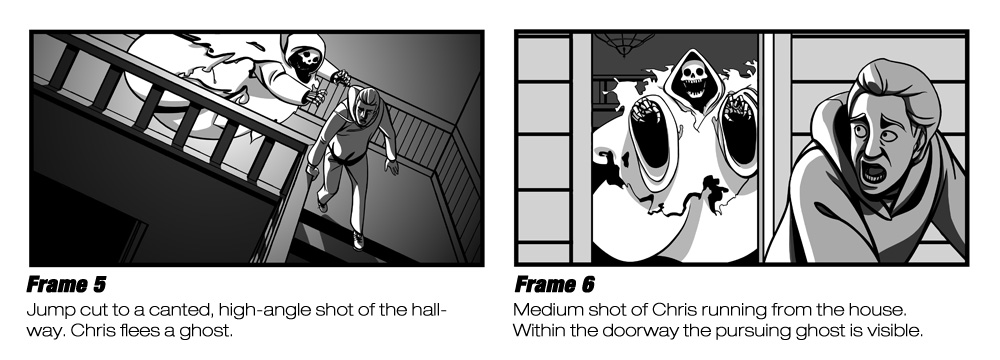
Things just got real! A dramatic turn occurs as a ghost chases Chris from the house.
When something significant like this happens, it’s perfectly fine to reverse the direction of movement on-screen. We’ve established that forward progress in this environment means right-to-left movement. Now that a dramatic development has happened, the corollary to that is backwards progress (retreat) means moving left-to-right. As long as you keep the visual logic consistent, it’s fine to change movement direction when the plot calls for it.
In frame 5, the character is seen from a high-angle, canted viewpoint. This reduces the power and control of the subject (why? because we’re looking down on him). The canted, or skewed, orientation of the frame further destabilizes the situation.
Frame 6 shows Chris fleeing the house. It’s another two shot, but this time the camera is much closer to Chris allowing the viewer to see his terror. His movement remains left-to-right.
Dialogue Continuity and Shot/Reverse Shot
Movement continuity is a major concern when composing a frame, but it is not the only continuity concern. Certain scenes have very little on-screen character movement in terms of people changing location. One example would be dialogue scenes where the characters remain seated.
In situations like this, continuity is still very important. I liken it to watching a tennis match. Imagine yourself seated in the bleachers, swiveling your head back and forth to follow a volley — right, left, right, and back again. It’s easy to tell who is who because the position of the athletes remains the same.
Now imagine the same tennis match, except every time you turn your head left or right the player positions are randomized. You wouldn’t be able to follow who was doing what.
That’s what dialogue continuity establishes: consistent character positions. In the examples below, imagine the invisible line connecting the two seated characters. This line splits the room into two halves. After choosing what side of the line you want the camera on, it needs to remain on that side for the duration of that sequence (cut-aways are an exception). The camera can move freely within one side of that invisible line, but if the camera jumps to the opposite side? That would throw the screen position of the characters into disarray.
This sequence is called “shot/reverse shot”, and it’s extremely effective. After establishing the scene, the shots ping-pong back and forth. The camera frames both participants of the conversation, alternating who is the focal character depending on what reaction is the most relevant.
Frame one is a standard establishing shot that sets up the positional relationship and context for the characters in the environment. Note the high-contrast lighting, indicating dramatic stakes in this conversation.
Frame two is the first part of this sequence, the “shot.” Both characters are framed in a medium shot so that nothing distracts from the conversation. Whichever character has the focus — in this case the younger man — that is the character facing the camera. Note: the focal character does not always have to be the one speaking.
Frame three depicts the “reverse shot” in this sequence. The camera flips positions to show the reaction of the other character, who now becomes the focus. This alternating focus would continue throughout the conversation as the characters react to one another.
Further Study
If it’s not already apparent, storyboarding technique informs a lot of the approach to how comic artists compose and arrange panels. I tried to cover all of the salient points in this two-part article, but there is so much more to discuss and learn. I would highly recommend that you locate a copy of Framed Ink: Drawing and Composition for Visual Storytellers by Marcos Mateu-Mestre (available through Design Press). I read multiple books to research this article, and that was, by far, the best resource I could find.
Additionally, it’s a good idea to watch films by critically-acclaimed directors in order to deconstruct how they tell a story visually. The medium may differ from comics, but you should steal techniques from it anyway.
makingcomics.com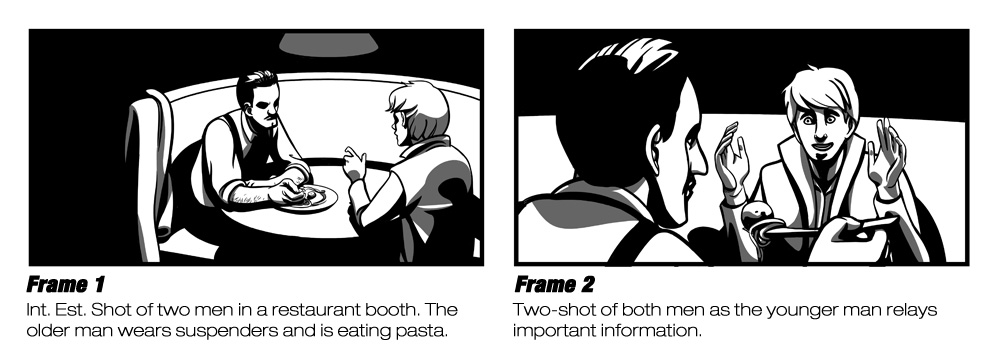
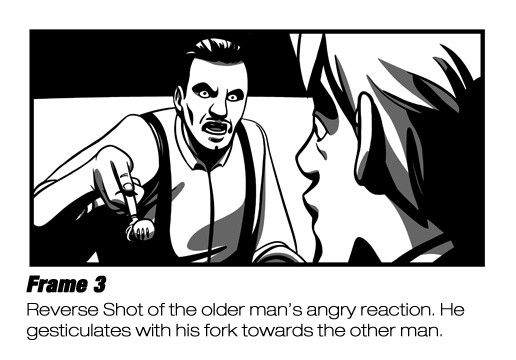
I wasn’t sure if people did storyboards for comics. I’m doing shot sketches while writing the script and I find each helps the other. Most of the storyboards will become panels later. Thanks for a good article. While looking for info on storyboarding for myself I found this youtube video that can help other people.
Thanks again.
Thanks Ron!
People do a form of storyboarding for comics, but it’s usually called thumbnailing. The process of breaking down a script into panels, and then making sure that those panels are effectively composed — that is the same.
Thanks for sharing that video, by the way. I’m looking forward to watching it later!
Thank a lot